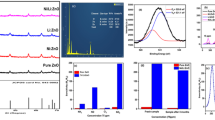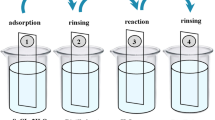Abstract
Li-doped NiO was synthesized by molten salt method. LiNO3-LiOH flux was used as a source for Li doping. NiCl2 was added to the molten Li flux and then processed to make the Li-doped NiO material. Li:Ni ratios were maintained from 5: 1 to 30: 1 during the synthetic procedure and the chemical compositions after characterization were found from Li0.08Ni0.92O to Li0.16Ni0.84O. Li doping did not change the basic cubic structural characteristics of NiO as evidenced by XRD studies; however, the lattice parameter decreased from 0.41769 nm in pure NiO to 0.41271 nm in Li0.16Ni0.84O. Hydrogen gas sensors were fabricated by using these materials as thick films on alumina substrates. The half surface of each sensor was coated with the Pt catalyst. The sensor, when exposed to the hydrogen gas blended in air, heated up the catalytic surface leaving the rest half surface (without catalyst) cold. The thermoelectric voltage thus built up along the hot and cold surface of the Li-doped NiO made the basis for detecting hydrogen gas. The linearity of the voltage signal vs H2 concentration was checked up to 4% of H2 in air (as higher concentrations above 4.65% are explosive in air) using Li0.10Ni0.90O as the sensor material. The response time T90 and the recovery time RT90 were less than 25 sec. H2 concentration from 0.5% to 4% showed a good linearity against voltage. There was minimum interference of other gases and hence H2 gas can easily be detected.
Similar content being viewed by others
References
Dirksen, J. A., Duval, K. and Ring, T. A., “NiO thin-film formaldehyde gas sensor,”Sensors & Actuators, B,80, 106 (2001).
Hong, Y. S., Han, C. H. and Kim, K., “Preparation of polycrystalline HT-LiCoO2 using molten salt synthesis method at 280 ‡C,”Chemistry Letters, 1384 (2000).
Hotovy, I., Huran, J., Siciliano, P., Capone, S., Spiess, L. and Rehacek, V., “The influences of preparation parameters on NiO thin film properties for gas-sensing application,”Sensors & Actuators, B,78, 126 (2001).
Hotovy, I., Huran, J., Spiess, L., Capkovic, R. and Hascik, S., “Preparation and characterization of NiO thin film for gas sensor application,”Vacuum,58, 300 (2000).
Hotovy, I., Rehacek, V., Siciliano, P., Capone, S. and Spiess, L., “Sensing characteristics of NiO thin films as NO2 gas sensor,”Thin Solid Films,418, 9 (2002).
Joint Commission on Powder Diffraction Spectroscopy-International Center for Diffraction Data, Swarthmore, PA, Card No. 04-0835 (1994).
Mackrodt, W. C., Harrison, N. M., Saunders, V. R., Allan, N. L. and Towler, M. D., “Direct evidence of O(p) holes in Li-doped NiO from Hartree-Fock calculations,”Chemical Physics Letters,250, 66 (1996).
Matsumiya, M., Qiu, F., Shin, W., Izu, N., Murayama, N. and Kanzaki, S., “Thin-film Li-doped NiO for thermoelectric hydrogen gas sensor,”Thin Solid Films,419, 213 (2002).
Matsumiya, M., Shin, W., Izu, N. and Murayama, N., “Nano-structured thin-film Pt catalyst for thermoelectric hydrogen gas sensor,”Sensors & Actuators, B,93, 309 (2003).
Matsumiya, M., Shin, W., Qiu, F., Izu, N., Matsubara, I. and Murayama, N., “Poisoning of platinum thin film catalyst by hexamethyldisiloxane (HMDS) for thermoelectric hydrogen gas sensor,”Sensors & Actuators, B,96, 516 (2003).
Qiu, F., Matsumiya, M., Shin, W., Izu, N. and Murayama, N., “Investigation of thermoelectric hydrogen sensor based SiGe film,”Sensors & Actuators, B,94, 152 (2003).
Qiu, F., Shin, W., Matsumiya, M., Izu, N., Matsubara, I. and Murayama, N., “Miniaturization of thermoelectric hydrogen sensor prepared on glass substrate with low-temperature crystallized SiGe film,”Sensors & Actuators, B,103, 252 (2004).
Sato, H., Minami, T., Takata, S. and Yamada, T., “Transparent conducting p-type NiO thin films prepared by magnetron sputtering,”Thin Solid Films,236, 27 (1993).
Schmidt, R. and Brinkman, A. W., “Preparation and characterization of NiMn2O4 films,”International Journal of Inorganic Materials,3, 1215 (2001).
Shin, W., Matsumiya, M., Izu, N. and Murayama, N., “Hydrogen-selective thermoelectric gas sensor,”Sensors & Actuators, B,93, 304 (2003).
Shin, W., Matsumiya, M., Qiu, F., Izu, N. and Murayama, N., “Thermoelectric gas sensor for detection of high hydrogen concentration,”Sensors & Actuators, B,97, 344 (2004).
Shin, W., Murayama, N., Ikeda, K. and Sago, S., “Thermoelectric power generation using Li-doped NiO and (Ba, Sr)PbO3 module,”J. Power Sources,103, 80 (2001).
Vakiv, M. M., Shpotyuk, O. I., Balitska, V. O., Butkiewicz, B. and Shpotyuk, L. I., “Ageing behavior of electrical resistance in manganite NTC ceramics,”Journal of the European Ceramic Society,24, 1243 (2004).
Wu, J., Nan, J., Nan, C. W., Deng, Y., Lin, Y. and Zhao, S., “Preparation and transport properties of Li-doped NiO and (Li+Ca)-doped NiO oxides,”Physica Status Solidi (a),193, 78 (2002).
Zainullina, V. M., Korotin, M. A., Zaikov, Y. P. and Shurov, N. I., “The electric structure and properties of Ni1-xLixO1-y (0⪯x⪯1/4, 0⪯y⪯1/ 8),”Solid State Science,6, 1139 (2004).
Author information
Authors and Affiliations
Corresponding author
Rights and permissions
About this article
Cite this article
Han, CH., Han, SD. & Singh, I. Thermoelectric hydrogen sensor using Li x Ni1-x O synthesized by molten salt method. Korean J. Chem. Eng. 23, 362–366 (2006). https://doi.org/10.1007/BF02706735
Received:
Accepted:
Issue Date:
DOI: https://doi.org/10.1007/BF02706735




